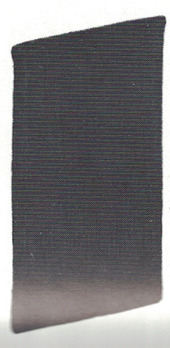RAD 2nd Pattern Arbeitsmann Collar Tabs
SKU: 80.GOR.03.02.02.02.007
Estimated market value:

Estimated market value:
Attributes
History
The RAD (Reichsarbeitsdienst = Reich Labour Service) was officially established on June 26, 1935 as the sole, and compulsory, labour service of Germany. Its purposes were to help the economy, curb unemployment, and indoctrinate its members with the NSDAP ideology, as well as play its part in militarising the German population.
The FAD (Freiwilliger Arbeitsdienst = Voluntary Labour Service) was the precursor of the RAD in the early 1930s. Official uniform regulations were first introduced on October 1, 1933, with modifications made in July 1934. It is also known as NSAD (Nationalsozialistischer Arbeitsdienst = National Socialist Labour Service).
The earliest uniforms were a not entirely successful attempt at standardisation. They gave way to a second wave of FAD uniforms that, when the RAD was established, experienced no significant changes.
The 1st pattern of RAD collar tabs had originally been introduced for FAD members. With the establishment of the RAD, those collar tabs were continued for a short period of time.
The 2nd pattern of collar tabs was introduced in 1936. A 3rd pattern was introduced in 1942, which was in use until the end of the war.
Certain collar tabs remained the same with a switch in patterns.
Collar tabs are made of cloth, often wool, with a buckram core, and are in the shape of a parallelogram.
The underlays of the collar tabs are in specific branch colours: members of the general branch wore a black underlay, the medical underlay colour was cornflower-blue, forest-green for administrative members, light blue for judicial members, and war correspondents wore a lemon-yellow underlay.
By a regulation introduced on July 6, 1934, Officers who had honourably retired received permission to retain their uniforms. They wore an underlay of corn poppy red (ponceaurot) cloth on the collar tabs.
Also as of July 6, Honorary Officers (Ehrenführer) wore an underlay in cavalry yellow, however, this was changed to white later in 1934.
The rank of Arbeitsdienstinspekteur was renamed to Oberstarbeitsführer on July 20, 1934.
The Gauarbeitsführer (later Oberarbeitsführer) and Obertruppführer ranks were introduced on July 20, 1934.
The rank of Unterfeldmeister was initially an Officer rank in the FAD, but with the establishment of the RAD it became the highest NCO (Non-Commissioned Officer) rank instead.
The lowest rank, Arbeitsmann, was initially known as Arbeitswilliger or Arbeitsfreiwilliger.
For the Senior Officers wearing an ear of wheat on their collar tabs, the stem faces inwards, towards the neck, when worn on an open-collar garment, but outward when worn on a garment with a closed collar.
1st pattern collar tabs were as follows:
Reichsarbeitsführer wore collar tabs featuring a gold-coloured ear of wheat with long “hairs”, and piped in gold-coloured cord.
Oberstarbeitsführer wore collar tabs featuring a gold-coloured ear of wheat with long “hairs”.
Oberarbeitsführer wore collar tabs featuring a silver-coloured ear of wheat with long “hairs”, and piped in silver-coloured cord.
Arbeitsführer wore collar tabs featuring a silver-coloured ear of wheat with long “hairs”.
Oberstfeldmeister and Oberfeldmeister wore the same collar tabs, featuring a silver-coloured segment with three red stripes, and ending in a point at the upper end.
Feldmeister and Unterfeldmeister wore the same collar tabs, featuring a silver-coloured segment with two red stripes, and ending in a point at the upper end.
Obertruppführer wore collar tabs featuring a white segment with two red stripes, and ending in a point at the upper end.
Truppführer wore collar tabs featuring a white segment with a red centre stripe, and ending in a point at the upper end.
Members in the rank of Obervormann wore collar tabs featuring a horizontal centre stripe in red with narrow white borders, ending in a point at the upper end and with a vertical white/black/white stripe at the lower end.
Members in the rank of Vormann wore collar tabs featuring a horizontal centre stripe in red with narrow white borders, and ending in a point at the upper end.
Members in the rank of Arbeitsmann wore blank collar tabs.
2nd pattern collar tabs were as follows:
Ranks of Reichsarbeitsführer to Generalarbeitsführer wore the same collar tabs, featuring a hand-embroidered gold-coloured ear of wheat within a gold-coloured frame, the inner part of which is in a “saw-edge” pattern.
Ranks of Oberstarbeitsführer to Arbeitsführer wore the same collar tabs, featuring a hand-embroidered silver-coloured ear of wheat within a silver-coloured frame, the inner part of which is in a “saw-edge” pattern.
Ranks of Oberstfeldmeister to Unterfeldmeister wore the same collar tabs, featuring a silver-coloured segment with a silver-coloured braided centre stripe, ending in a point at the upper end and with a triangular indentation at the lower end.
Obertruppführer and Truppführer wore the same collar tabs, featuring a white segment with a grey centre stripe, and ending in a point at the upper end.
Members in the rank of Obervormann wore collar tabs featuring a horizontal white bar with a grey centre stripe, ending in a point at the upper end and with a vertical white/black/white stripe at the lower end.
Members in the rank of Vormann wore collar tabs featuring a horizontal white bar with a grey centre stripe, and ending in a point at the upper end.
Members in the rank of Arbeitsmann wore blank collar tabs.
3rd pattern collar tabs were as follows:
Ranks of Reichsarbeitsführer to Generalarbeitsführer wore the same collar tabs, featuring a hand-embroidered gold-coloured ear of wheat within a gold-coloured frame, the inner part of which is in a “saw-edge” pattern.
Ranks of Oberstarbeitsführer to Arbeitsführer wore the same collar tabs, featuring a hand-embroidered silver-coloured ear of wheat within a silver-coloured frame, the inner part of which is in a “saw-edge” pattern.
Ranks of Oberstfeldmeister to Unterfeldmeister wore the same collar tabs, featuring a silver-coloured segment with diagonal lines, with a silver-coloured braided centre and bottom stripe, ending in a point at the upper end and in a “fish fin” with horizontal lines at the lower end.
Ranks of Haupttruppführer to Arbeitsmann wore the same collar tabs, featuring a machine-woven white/grey diagonally striped segment with a black centre stripe, ending in a point at the upper end and in a horizontally striped “fish fin” at the lower end.


Comments
Sign in to comment and reply.


Scroll Top